OGOF WHAT?
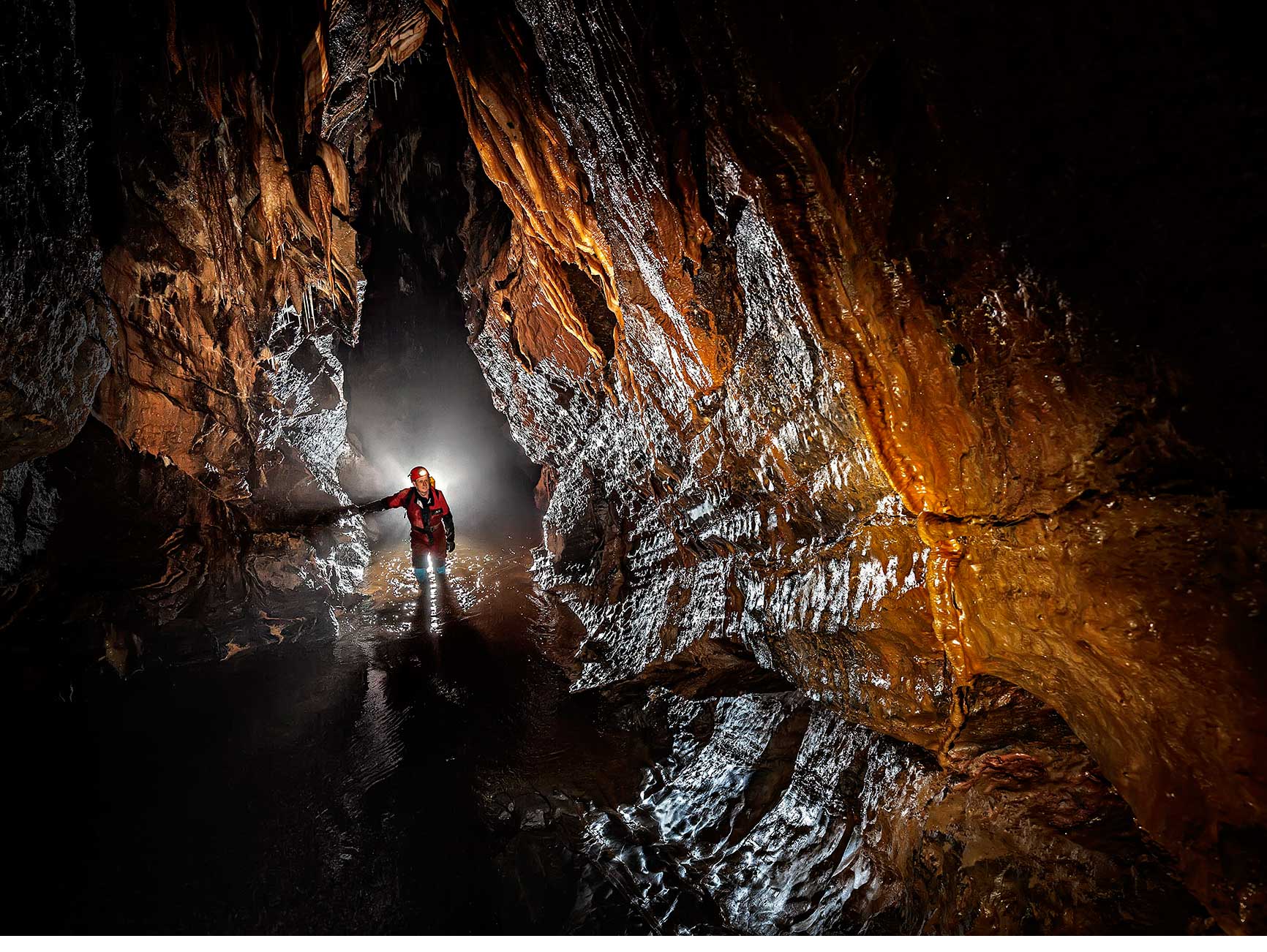 Llygad Llwchwr. Photo copyright Chris Howes and used with his kind permission. Llygad Llwchwr. Photo copyright Chris Howes and used with his kind permission.
With lockdown easing and caving
back on the agenda, Dickon Morris has put together some information
about Welsh cave names, in the hope of tempting a few folks over the
border as soon as restrictions allow.
When asked what they think is the second most widely spoken language in
the British Isles most people will tend to guess a language such as
Hindi, Arabic or Polish (although that last guess is less common now
that Brexit has completed). In actual fact the correct answer is Welsh
which is just one of five indigenous Celtic languages spoken at least to
some extent in these islands. The other four being Scottish Gaelic,
Irish Gaelic, Manx and Cornish. Of these five languages, Welsh, is by
far the most vibrant and widely used.
The question as to how many people speak and understand Welsh is a
difficult one to answer. Within the borders of Wales itself data on
Welsh language ability is collected as part of the decennial census. The
last census in 2011 suggested that 19% of the population (562,000)
could speak Welsh which represented a decline of 14,000 speakers since
the 2001 census and a larger decline when taken as a proportion of total
population, which had increased. However, the annual population survey
by the Office of National Statistics for the year ending September 2020
showed the proportion of people able to speak Welsh had increased since
the 2011 census to 28.8% of the population (876,200). If this seems like
a rather unbelievable jump in bilingualism then that’s because it
probably is.
These surveys are all self-reported (obviously the census does not
require you to prove your language ability) and the debate about what
level of proficiency in a language allows you to declare yourself a
‘speaker’ can fill hours in the pub. There are also large numbers of
Welsh speakers living in other parts of the UK but this is much harder
to estimate as the only people that will be noted on the census as Welsh
speakers outside of Wales are those who say that their main language is
Welsh. Clearly those who live and interact with people who do not speak
Welsh are unlikely to claim it as their main language.
With all that considered it can probably be said that 1-2% of British
residents are proficient in the language which is impressive considering
the efforts made to stamp out the language entirely in the past - but
let’s not get into that!
While that is not an insignificant number it is low enough that it can
be safely considered that the majority of UBSS Newsletter readers will
not be Welsh speakers and that this article will be mostly new and
interesting information. For my part I can count on the fingers of two
hands the number of cavers I am aware of who speak Welsh.
While there is a rich variety of literature and music produced in the
language each year, a decent radio station and slightly less spectacular
television channel, these things are invisible to anyone who is not
looking for them. The notable exception being the glorious national
anthem which is belted out with great enthusiasm at every major sporting
event in which Wales are playing.
No, the main exposure that most British people have to Welsh is the
place names which they encounter when they visit Wales on holiday, or to
go caving of course.
The reaction to these names is not always positive and I’m sure we’ve
all heard a joke or two. Incidentally the Welsh language actually has
seven vowels (all of the English ones plus w and y) so it is actually
English that is lacking in vowels. Not to mention that its only Scrabble
gone wrong if you’re using the wrong version of the game (i.e. the
English one!).
Joking aside these place names can be rather difficult to pronounce for
those not familiar with the language not to mention the fact that they
make no sense at all. The aim of this article therefore is to enlighten
the majority of cavers who are not familiar with the Iaith o Nefoedd
(Language of Heaven) and hopefully make your next visit to Wales more
interesting.
Place Names Across Mainland Britain
The history of Mainland Britain is
reflected in its place names. When a place was first named it would
obviously have been given a name in the language of the people who lived
in that area at the time. However, the original name did not always
stick when new people came along (one can hardly imagine that the Native
Americans who lived around the island of Manhattan would have called it
that prior to European settlement).
In Wales the meanings of the vast majority of place names is immediately
obvious to a Welsh speaker and this is because the majority of Wales
has been continuously inhabited by speakers of Welsh for over 2000
years. Prior to the gradual anglicisation of the nation that has
occurred over the last several hundred years the linguistic make-up of
the nation had not changed significantly since the departure of the
Romans. However, the influx of English speakers has already left its
mark with the large number of anglicised place names in South and East
Wales (although the original Welsh version is usually still retained as
an alternative). Furthermore, many place names in South Pembrokeshire
are fully anglicised with no Welsh version remaining which is indicative
of the fact that this has been a majority English speaking area for
almost 1000 years.
To the east of Offa’s Dyke in England the picture is far more
complicated and while some place names make sense to an English speaker
(e.g. Wells), many others do not (e.g. Kirkby Lonsdale). This is a
result of the fact that the demographics (and therefore linguistics) of
England shifted many times between the departure of the Romans and the
arrival of the Normans in 1066.
This means that many of the place names originate from languages that
have been pushed out and are no longer spoken, including Norse
languages, Saxon languages and, on the borders, the Celtic languages
that still dominate place names on the fringes of the island of Britain
in Scotland, Wales and Cornwall.
For example, many place names in the north of England have their roots
in Cumbric which was a Celtic language very closely related to Old
Welsh. The names Cumbria and Cymru (Wales) share a common root. The name
Pen y Ghent is partially comprehensible to a modern Welsh speaker
meaning the head / top of something with the word Ghent not present in the modern language.
The Caves
There are hundreds of caves in South Wales
and a good number in North East Wales. The vast majority of these have
Welsh names although there are a minority that have been given English
names. For example, Little Neath River Cave which may be better off as
Ogof Afon Nedd Fechan. In any case what follows is a run through some of
the more interesting cave names and their meanings with an approximate
phonetic spelling for English speakers.
Llygad Llwchwr Ll-uh-gad Ll-oo-ch-oo-r
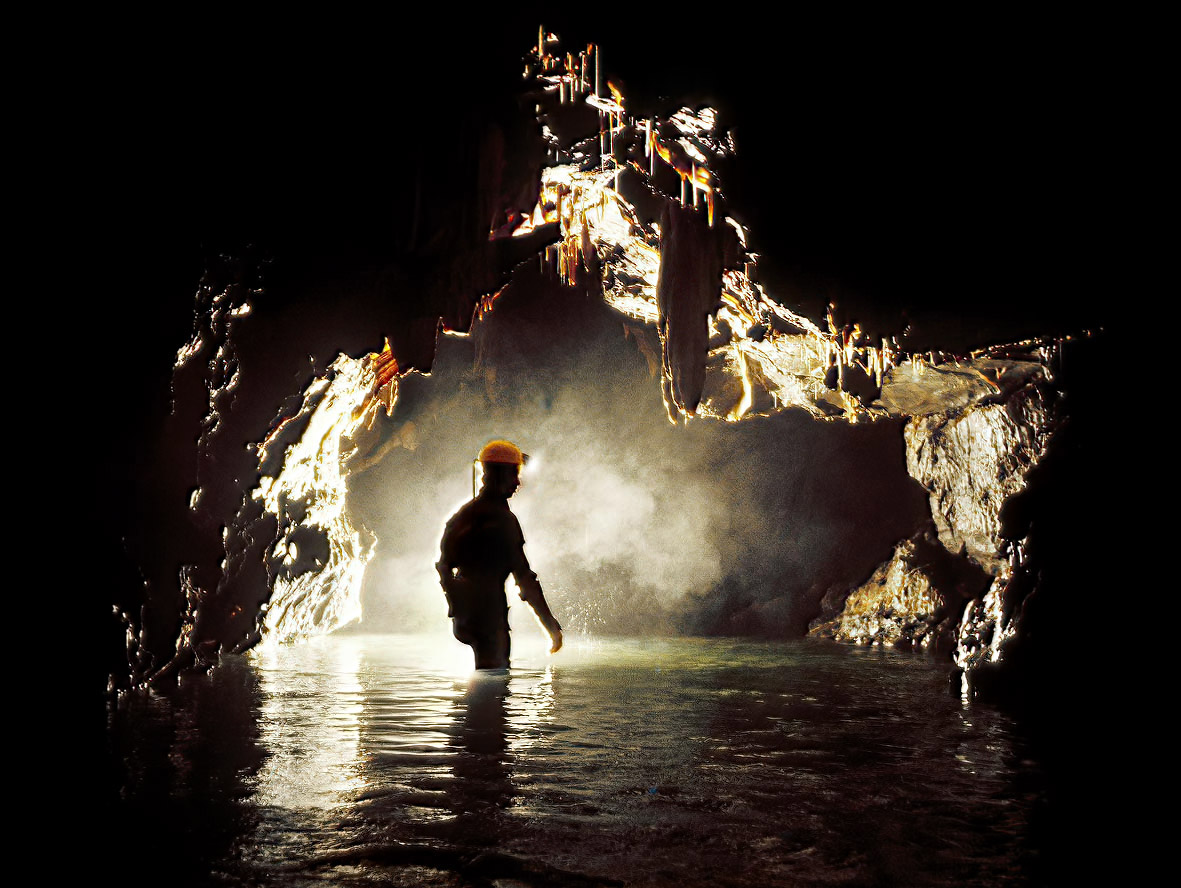
Llygad Llwchwr. Photo copyright Chris Howes and used with his kind permission.
Eye of the Lougher. The Lougher is the river which flows out of the entrance to the cave.
Dan yr Ogof Dan uhr Og-ov
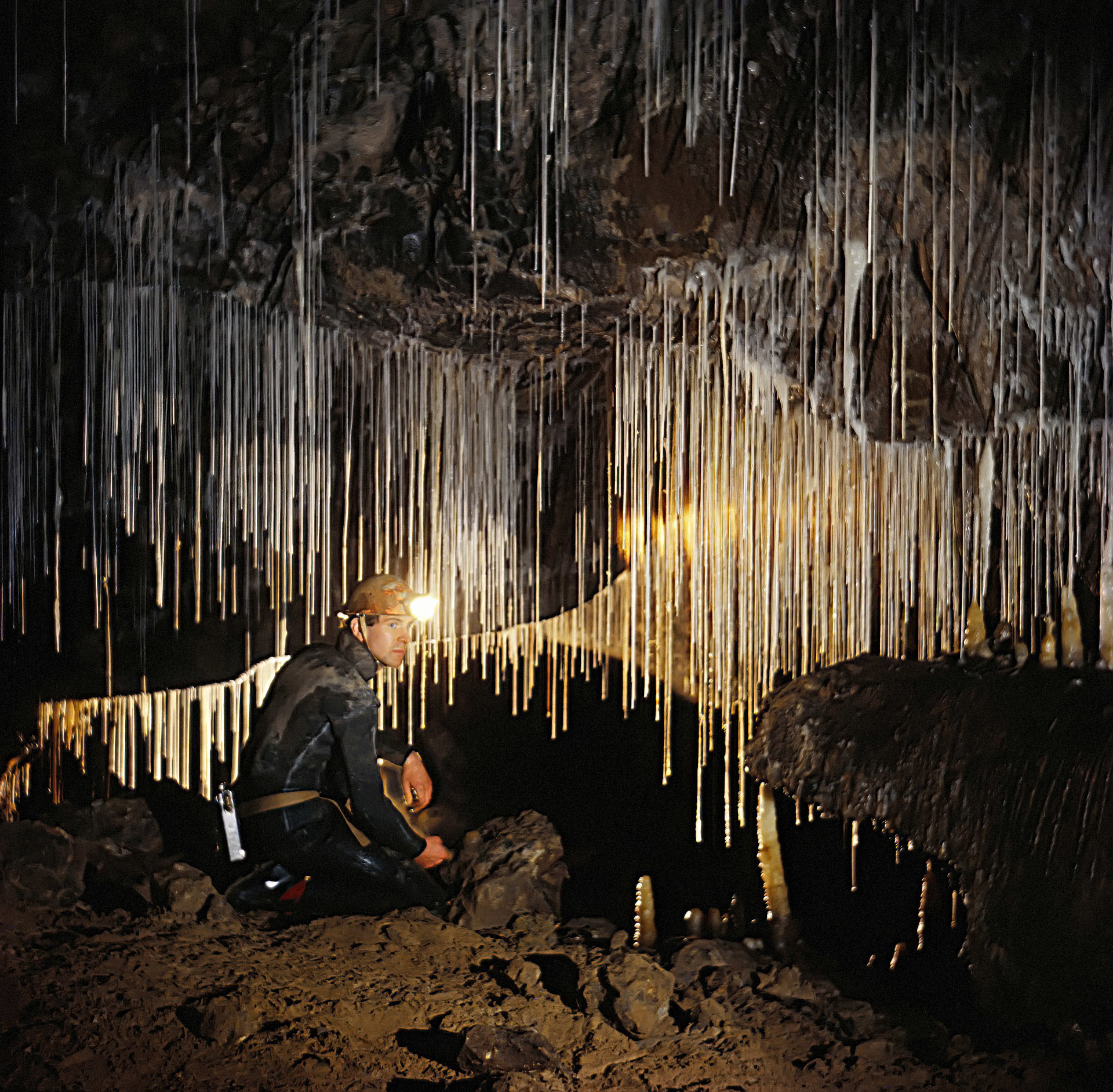
Dan yr Ogof. Photo copyright Chris Howes and used with his kind permission.
Quite possibly the finest cave in the country. The name literally means ‘Under the Cave’ which appears to make no sense as it is
the cave. However, it seems that the cave is named after the farm which
sits below the resurgence which could quite sensibly be named Dan yr
Ogof.
Ogof Ffynnon Dhu Og-ov Fun-non Thee
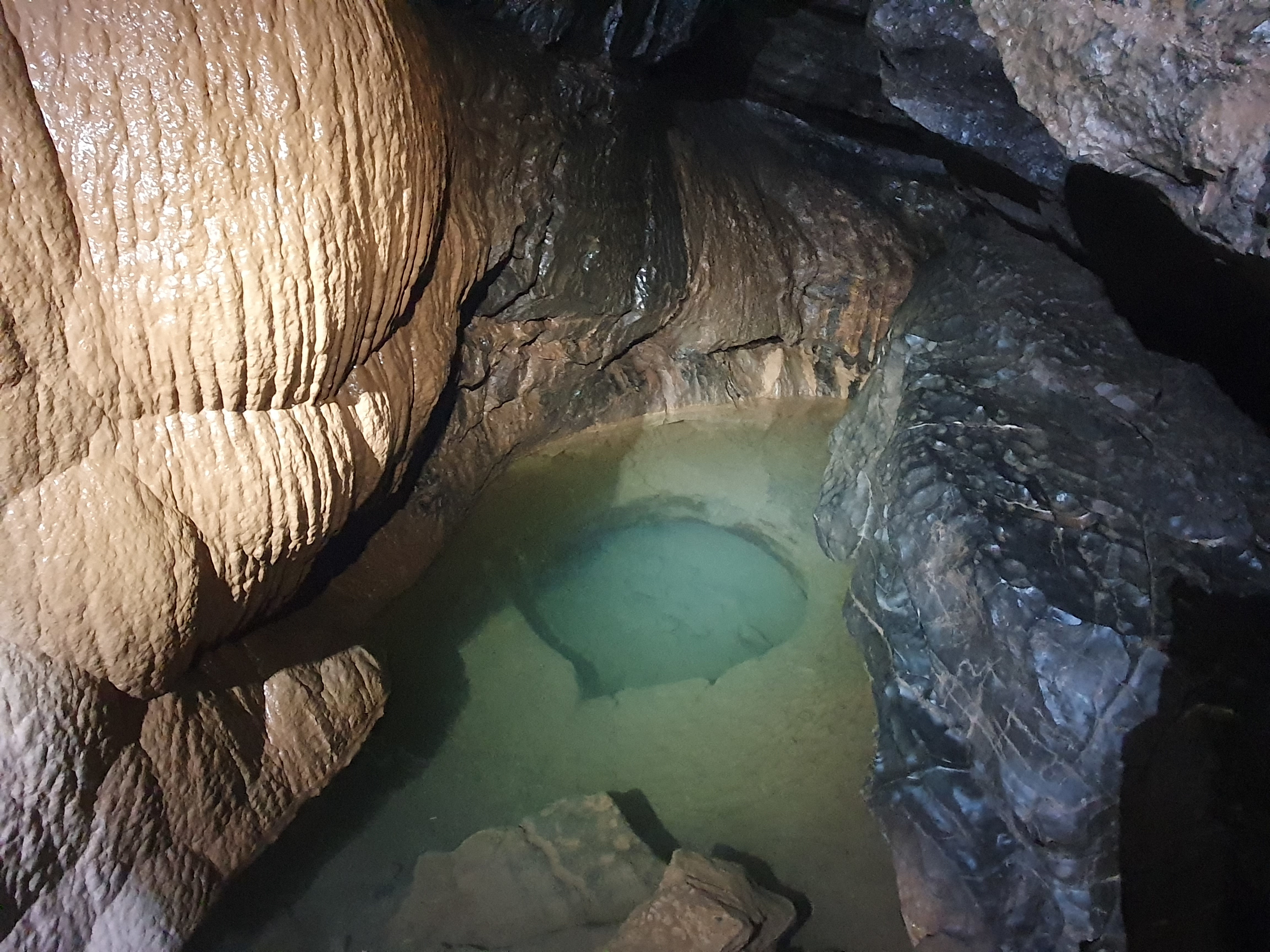
Pluto's Bath. OFD 1. Photo by Linda Wilson.
Cave of the Black Spring. Interestingly the slightly controversial top entrance is labelled as Ogof y Noson Hir on the survey which means Cave of the Long Night although for some reason this name does not seem to have made it into English.
Pant Mawr Pant Ma’-oohr
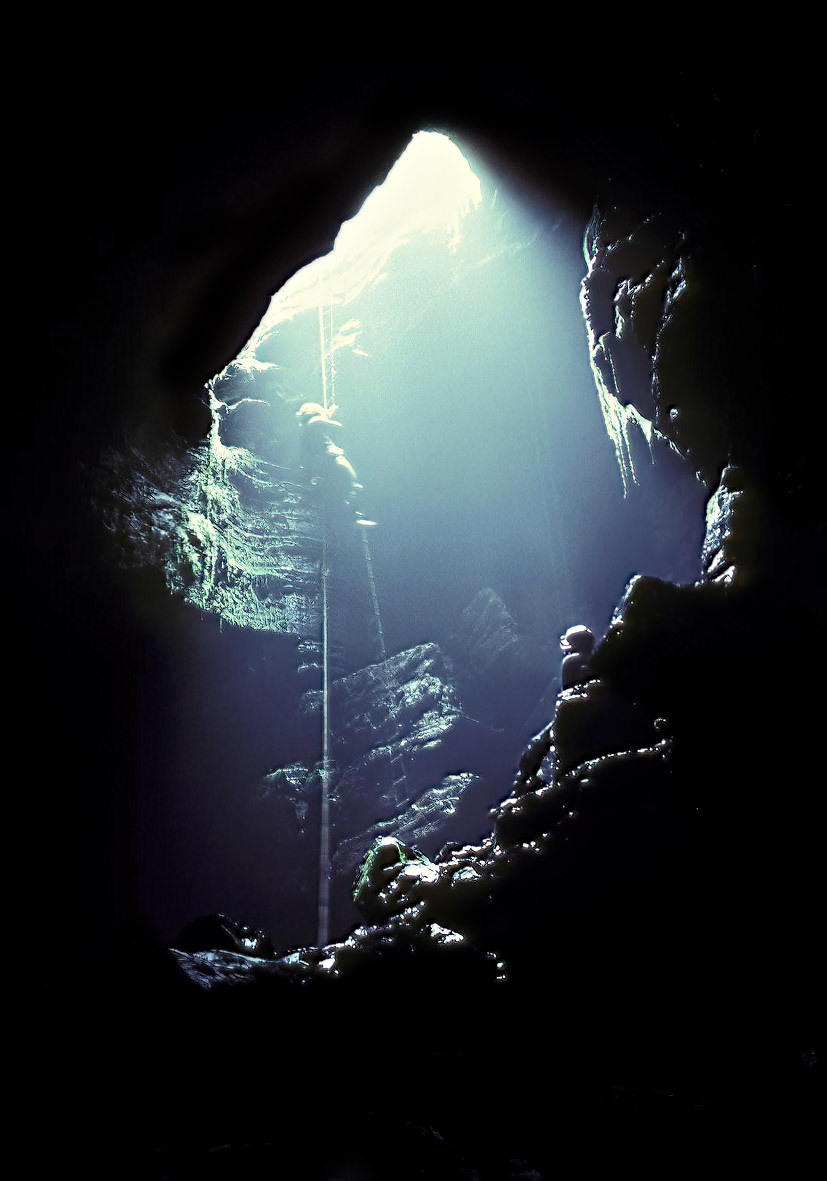
Pant Mawr. Photo copyright Chris Howes and used with his kind permission.
This means big dip which could be quite reasonably applied to any cave which begins in a large shakehole.
Ogof yr Ardd Og-ov uhr Ar-th (soft th as in then not as in thunder)
This is a little known and fairly tedious cave close to the South Wales Club hut at Penwyllt (Wild
Top) but the name is interesting and means ‘The Garden Cave’ which is
hardly surprising seeing as it sits in a paddock to the rear of an
activity centre.
Ogof Cul Og-ov Keel
A small cave to the west of Ystradfellte (Vale of the River Mellte) meaning quite literally ‘Narrow Cave’ which could quite easily be applied to many caves.
Ogof Fechan Og-ov Veh-ch-an
Simply meaning ‘Small Cave’ in a similar vein to another significant cave on the same mountain called Ogof Fawr which means ‘Big Cave’.
Ogof Rhy Sych Og-ov Rheed See-ch
A fantastic aquatic cave near Merthyr Tydful which means ‘Cave of the
Dry Ford’. Although I do not personally know of any fords in the area
this most likely refers to a nearby ford which is usually dry due to the
fact that the water is underground in the cave.
Ogof Tarddiad Rhymney Tarr-th(soft)-ee-ad Ruh-m-knee
A cave which has been traced to the Rhymney Rising and unsurprisingly
means something along the lines of ‘Cave of the Source of the Rhymney’.
Admittedly it doesn’t translate that well into English and seems a
little clumsy.
Ogof Cynnes Og-ov Cun-ness
Meaning ‘Warm Cave’, so called because it was originally discovered on a
winter’s day with snow lying on the ground which had been melted by the
warm draft blowing out of the cave.
Agen Allwedd Ag-en Ah-ll-oo-eh-th(soft)
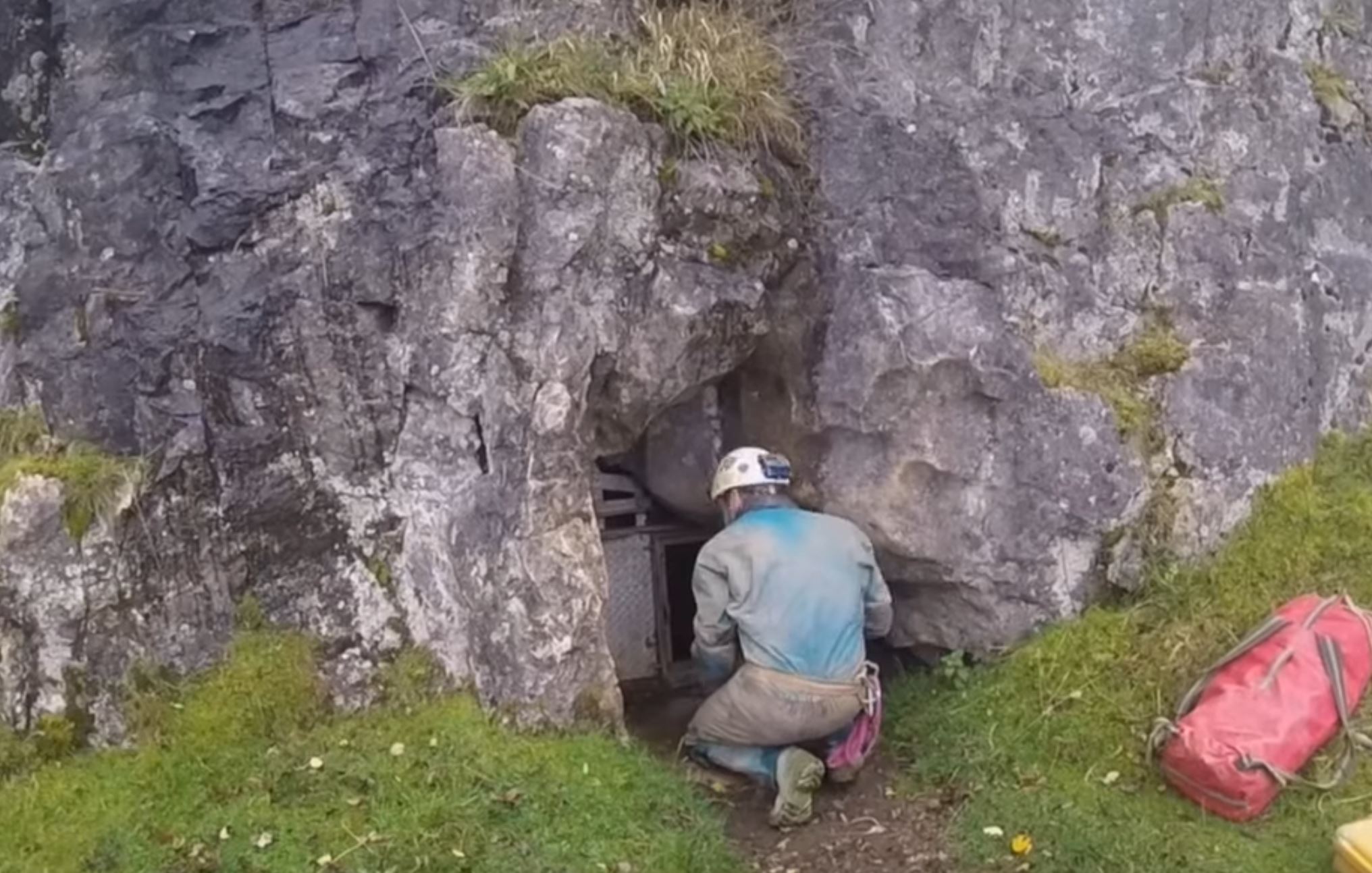
Aggy Entrance. Photo from a film by Andy and Antonia Freem and used with their kind permission.
‘Key Slot’ although personally I’ve never seen the resemblance.
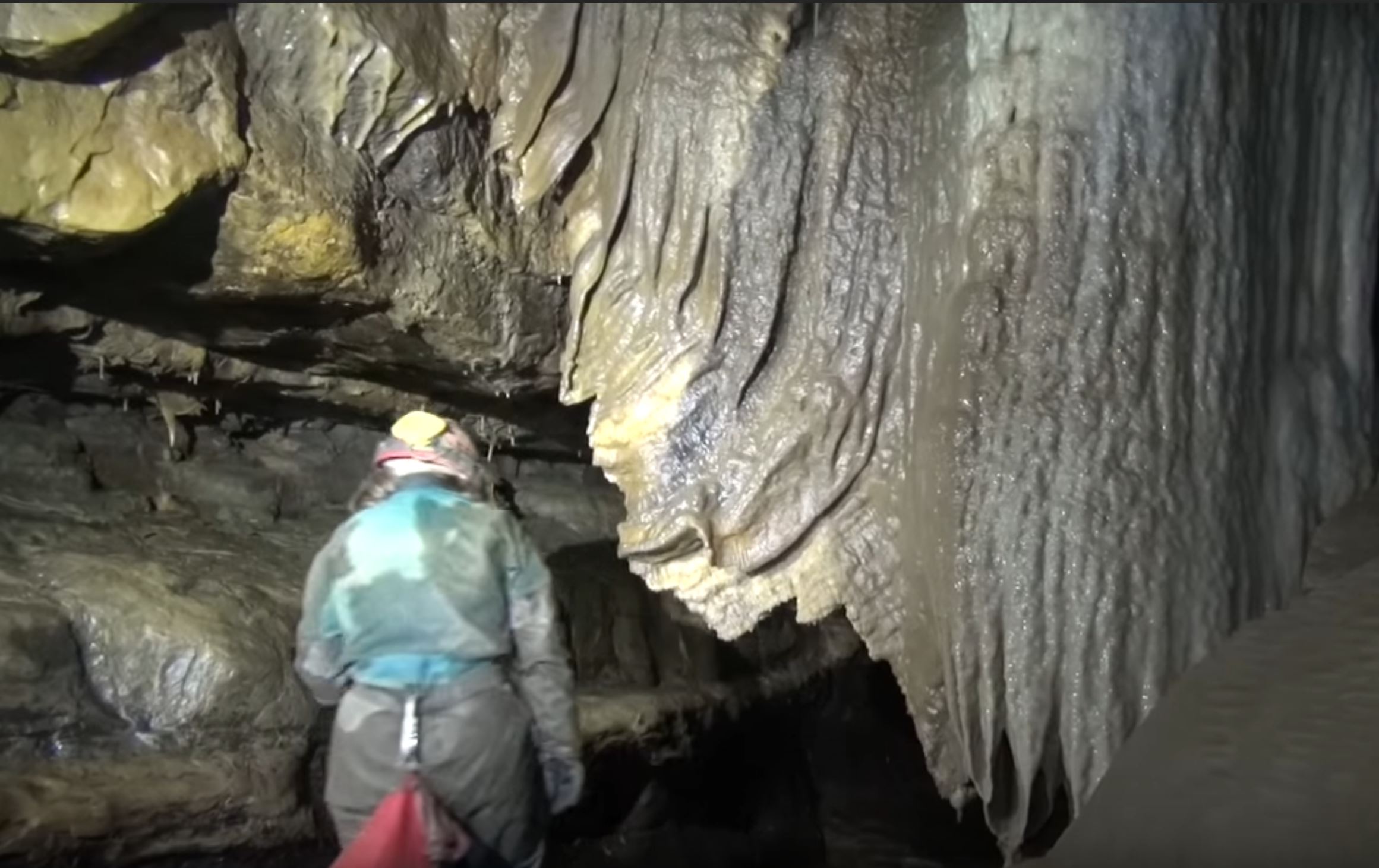
Aggy, Turkey Passage. Photo from a film by Andy and Antonia Freem and used with their kind permission.
Eglwys Faen Egg-loo-us Vine
Literally meaning ‘Stone Church’. This cave has been known for many
years so it is certainly possible that the large chamber near the
entrance was used as a place of worship at some point in the past.
Siambr Ddu Sham-brr Thee
A cave formed by the collapse of Pennant Sandstone beds into large chambers in the underlying limestone (Ogof Draenen).
The cave is therefore entirely formed within the Pennant Sandstone (a
coarse sandstone similar to the Millstone Grit found outcropping across
the north of England) with black walls and roof hence the name Siambr Ddu which means ‘Black Chamber’.
Ogof Draenen Og-ov Drain-en
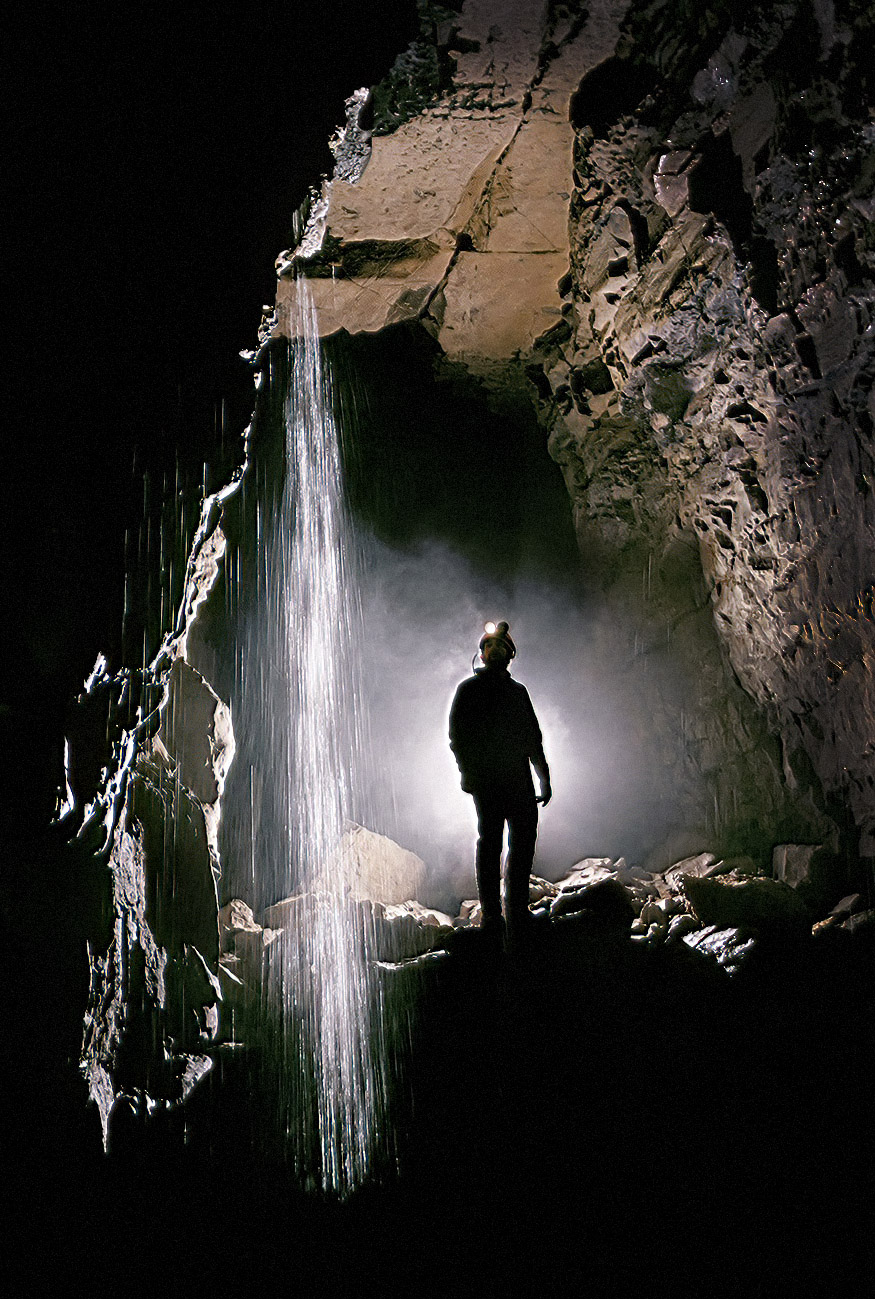
Ogof Draenen (upstream). Photo copyright Chris Howes and used with his kind permission.
Without a doubt the longest cave system in
the British Isles although two thirds of it is yet to be discovered. The
name simply means ‘Thorn Cave’ which supposedly refers to the hawthorn
bushes around the original entrance although is also a very appropriate
name considering the thorny and protracted debate around the various
entrances.
Pronunciation
Fortunately, the majority of the letters of
the Welsh alphabet (of which there are 28) are not as unfamiliar to
English speakers as you may have imagined although ll, rh and ch have no
equivalent in English and are likely to be a bit of a challenge
(although the ch sound is present in the Scottish word loch).
Furthermore, unlike the English language, which is notoriously difficult
for learners due to the fact that there are so many alternative
pronunciations of letters in different words Welsh is entirely phonetic
meaning that once you have learned the alphabet you should theoretically
be able to pronounce any word that you read on the page although this
is very much easier said than done for a native English speaker due to
the way that the letters are often combined. Good luck!
Thanks to Enid Evans for checking the Welsh content (I am not a native speaker) and adding the phonetic translations.
Dickon Morris
|
|
THE MYSTERY IS REVEALED - IRON ACTON CAVE
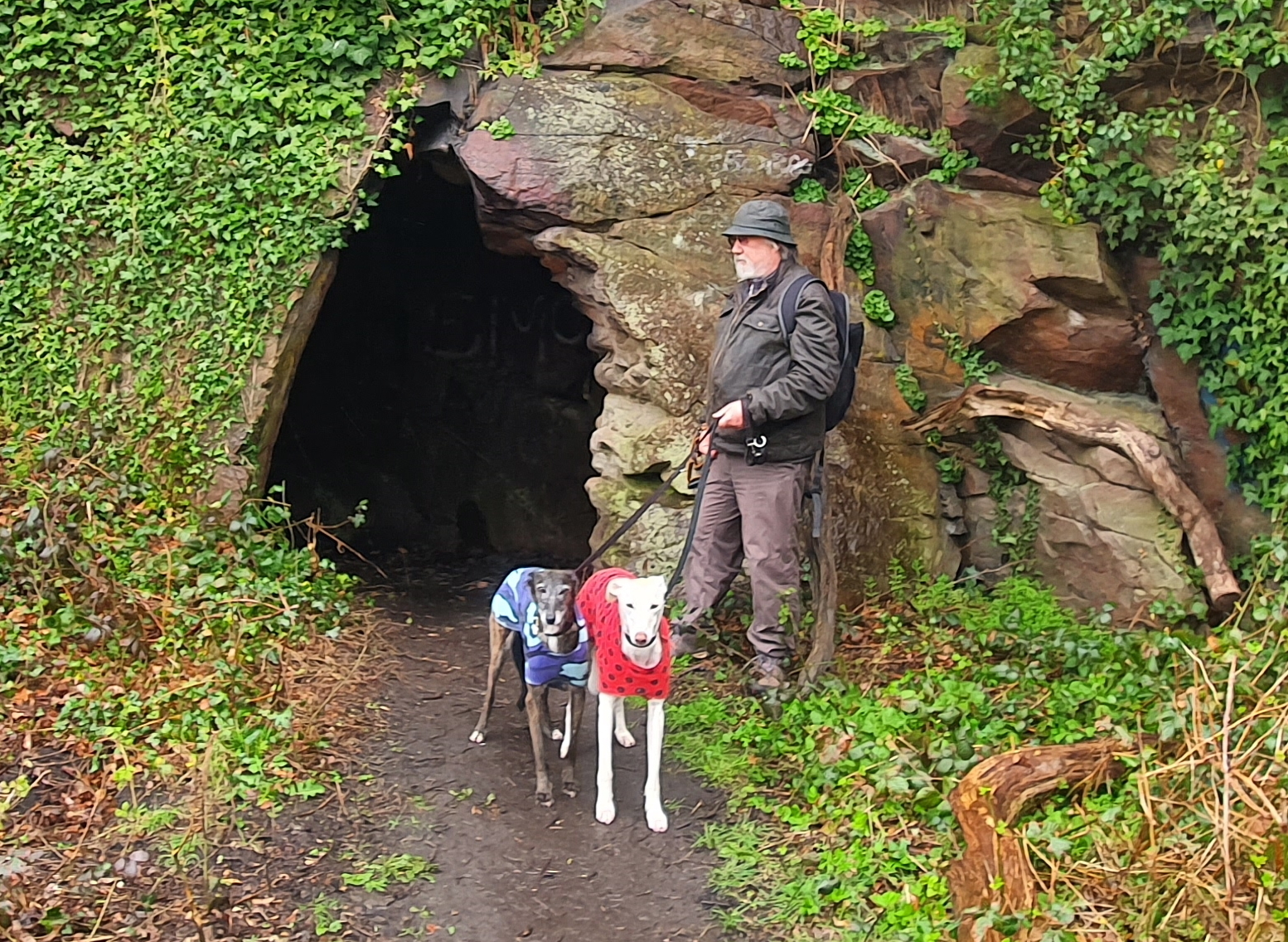
Graham outside Iron Acton Cave with Lady (left) and Trigger (right).
As part of Things To Do In Lockdown
(Volume 54), Graham and Linda took a trip to one of the areas lesser
known caving regions just north of Bristol to visit yet more caverns
measureless to man.
Many years ago, I came across a handwritten
account of Iron Acton Cave by 'Porthos' Taylor, donated to the society
in a collection of other papers by his widow, and so on 29th March 1987,
clutching his description, Graham and I set off with Tony Boycott and
our first generation of dogs (Scruffy and Beela, for those who remember
them) to follow in his footsteps. We found the cave without difficulty
and I even did a sketch of the entrance, with Graham and Scruffy for
scale. Beela was investigating the interior at the time.
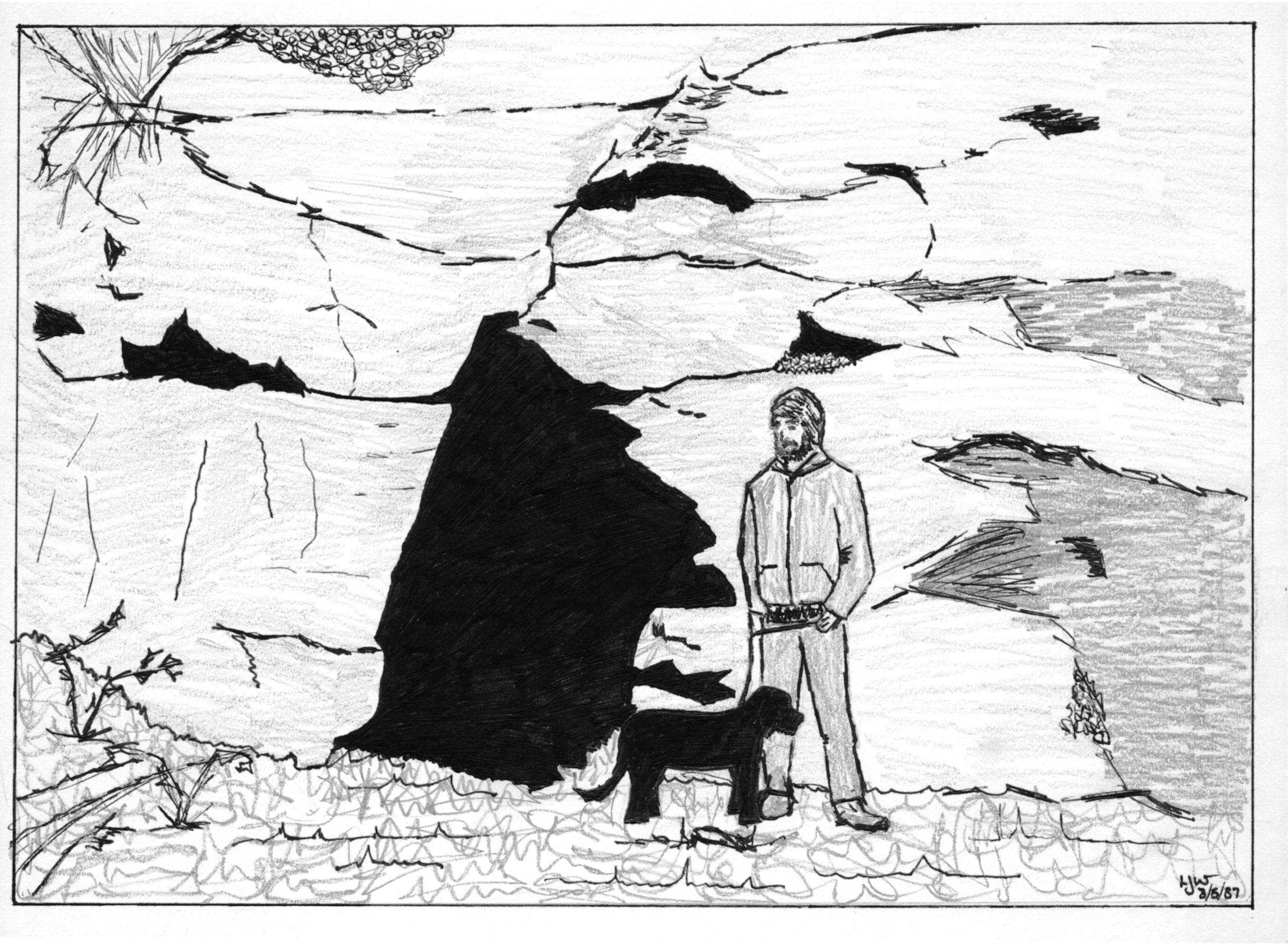
My sketch made on 3 May 1987. There was a lot less ivy then.
We followed the description in Porthos'
account (reproduced below) and the following is taken from the
description I wrote at the time for the Newsletter but never got around
to submitting to the then editor (apologies to whoever it was at the
time!). We followed Porthos' description, although according to Graham,
the grid reference he gave is wrong and should be NGR ST 6788 8287.
There is parking by the bridge over the nearby river and there is now a
very obvious nature trail beside the river to the weir. Almost 34 years
ago to the day, I noted that ... 'The recent heavy rains had swollen the
river to such an extent that the low-lying fields on either ban were
completely flooded and the course of the river was lost for some way,
the only indication of its correct channel was a footbridge, rising
straight out of a lake and disappearing back into it, with only the tops
of the fence posts to show the line of the track leading to and from
it." It was a lot drier when we visited at the end of March this year.
Returning to my original notes ... "The
cave itself lies at the foot of a sandstone outcrop, which appears to
have been quarried. The large entrance leads to a chamber approx .... by
.... with a flat floor, showing the usual evidence of human habitation
(albeit temporary) on the floor: a camp fire, picnics and coke cans. By
bridging up the left hand end of the chamber - and getting covered in
red mud - I was able to ascertain that there were no passages
leading off the chamber, although there did appear to be evidence of
water running into the chamber and down the walls through a narrow rift,
this is nothing more than surface water running down through the rock.'
And so endeth my previously unpublished account from 34 years ago. To
complete the description, I think the chamber is approximately two
metres wide, one metre deep and two metres high.
Looking at it now, I have no idea how I managed to bridge up the wall!
And with modern lights it wasn't necessary to reprise that performance
as my Fenix clearly showed there was nothing of interest at the top of
the climb. On this occasion, there was a lot less detritus on the floor,
but there was considerably more paint-spray graffiti on the wall (with
little or no artistic merit apart from one small drawing of a dog's
head).
This was Lady's last walk, and it was very special to visit the cave
with her, our 3rd female dog. Trigger is our 4th generation male dog and
has a new 4th generation companion, Lady's very worthy successor, Gwen
Greyhound. It's a really nice walk, so I don't think we'll leave it
another 34 years before returning. I might even have another go at
climbing the wall next time!
No one correctly guessed the cave, so there are no prizes to hand out,
but well done to Clive and Elaine for trying. Clive's guess was Sally's
Rift and Elaine thought it was 'the little cave in Chill Wood next to the Frome.'
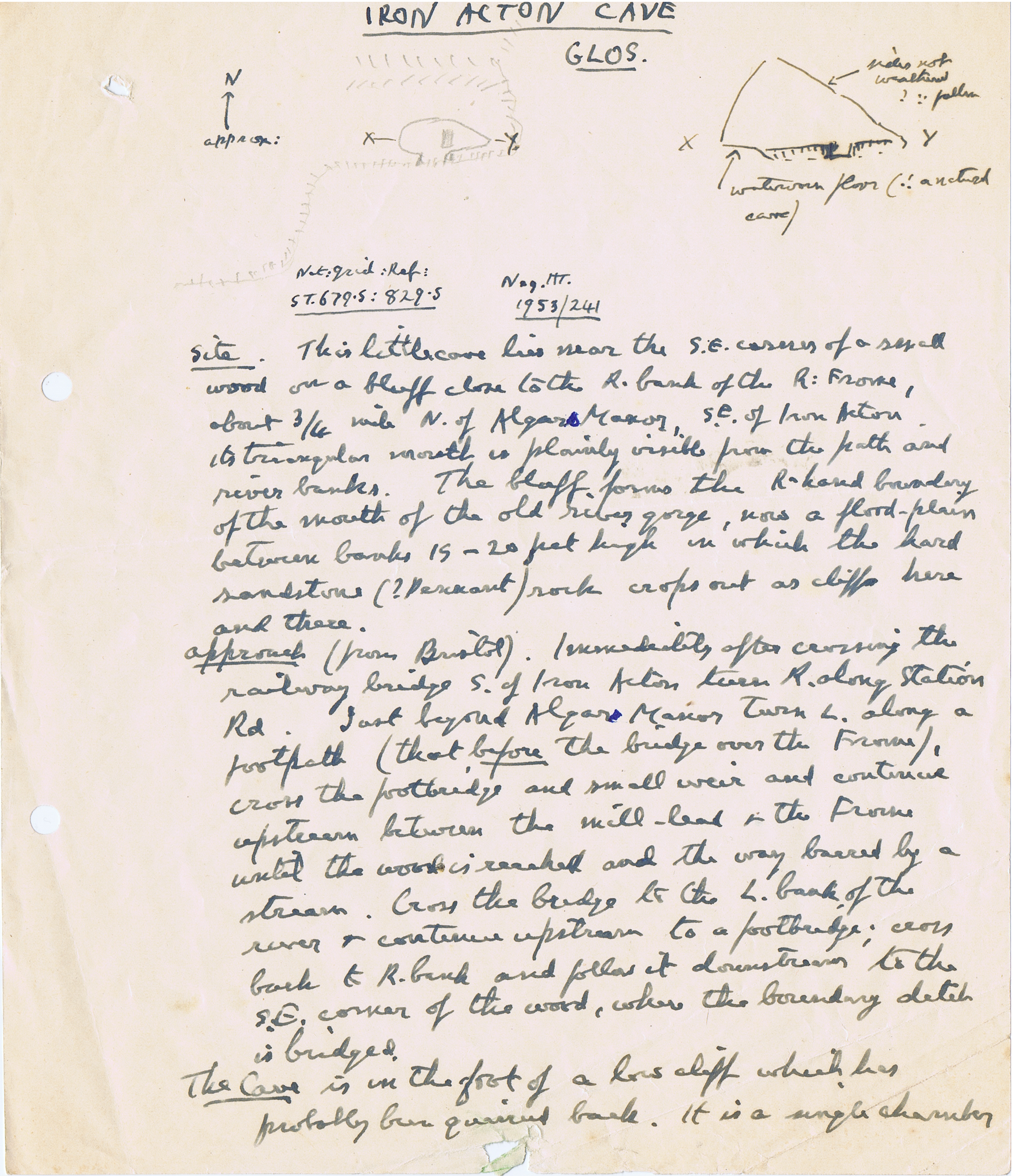
You can
probably tell from his handwriting that Porthos was a doctor. It's not
too bad here, but in some of the archaeological logs, it's almost
indecipherable.
Porthos also notes the possibility of some
other caves in the area that might be worthy of further investigation,
so if anyone fancies a nice walk in the countryside, make sure you take a
camera or sketchbook and don't leave it as long as I did to submit your
report to the newsletter!
Linda Wilson
|
|
THE DRAGON READ TO THE END - DID YOU?
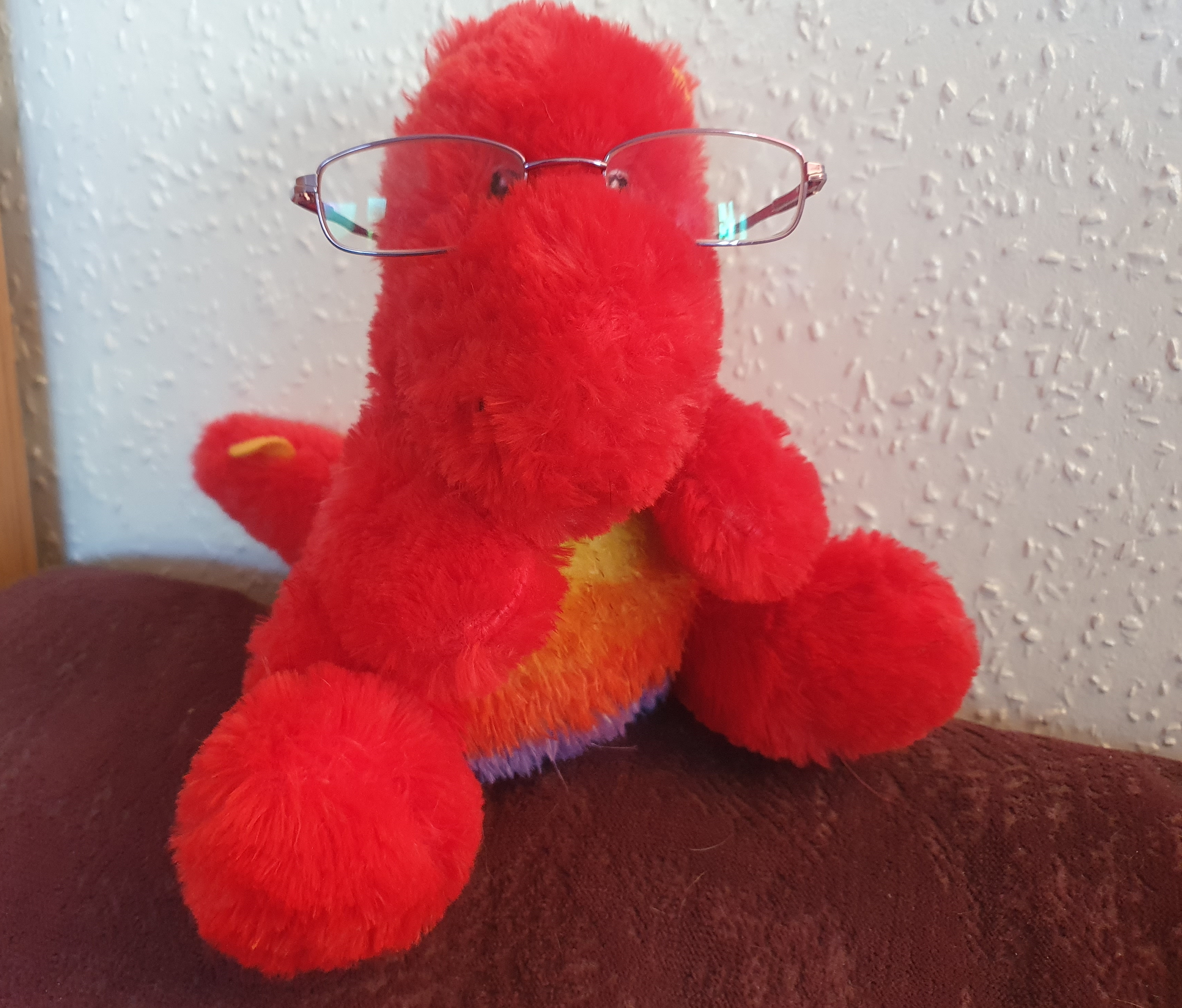
The winner of last month's
competition was Jan Waker, who was very quick off the mark! Keep the
emails coming! It's a real bonus for your editorial team, slaving over a
hot computer, to know there's a readership out there, busy finding
excuses not to do any real work!
- Great
newsletter this time; lots of fascinating stuff, but I must admit that
my two favourite bits were the insect up the arm story (ugh!!!) and this
quote: “Previously to this, the only change in the photos was the door
falling off one of the cars at the very top of the Gorge.”, which for
some reason just tickled my funny bone. (Jan Walker)
- I’m procrastinating while waiting for my training course
to start! Good work, everyone, and I am tittering at both the Hon
Moneybags and the goat being paid more than Rick! (Sharon Wheeler
and the blessed FT Bear)
- Yes, yes, once more unto the end, dear friends, once more. Cry
‘Good for Cuthberts! Britain! And Saint Swithins!’ (William Shookspear
aka Chris Howes)
- During my tenure as editor be prepared to be bored to death by
my instance that comp sci does have a place in the newsletter! (Zac
Woodford)
- (well, I skipped a few bits here and there, but I read
the GB Cave rockfall bits twice.) (Hans Freiderich}
- Yes I did read to the end, but got distracted by a rockfall… (Andy Farrant}
- Anyway, I got to the end. You were surprisingly polite about the younger me photo. (Dick Willis)
- Good newsletter BTW. The article on slaughter was very interesting. (Dickon Morris)
- Only a fortnight late! (in my defence, I've been caving...) (Elaine Oliver)
Now,
who read to the end this time? Late entries accepted! For those new to
the game, there will be a splendid prize for the first person to read to
the end and tell us that you did!
THE END
|
|
|
|